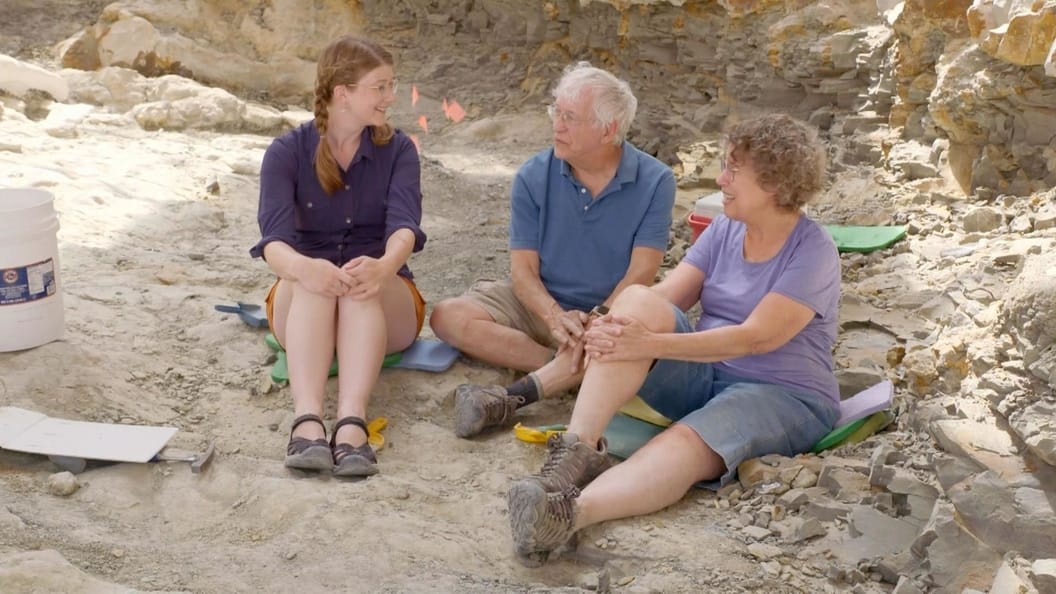How Can We Make Paleontology More Accessible to the Public? | Stops | Prehistoric Road Trip
During the summer at the Wyoming Dinosaur Center (WDC) in Thermopolis, paleontologists aren’t the only ones who can get out a fossil brush and bucket and start wiping away the earth to expose a dinosaur bone. The public can, too.
That’s by design, says WDC paleontologist Jack Turnbull. The goal was not only to have a museum full of fossils, but also a place where people could learn through a literal hands-on approach.
For museums around the world, it can be a challenge to engage the public in an active rather than passive way and make the sometimes-dense topics – especially the sciences – more accessible.
“For kids, there isn’t much of a challenge,” Turnbull said. Children who visit the WDC, he said, are usually pretty jazzed to look at dinosaurs and other fossils. They’re the “catalyst” for bringing their parents through the front door.
“Adults get so caught up in the modern world and their busy lives, and depending upon what their educational background is, they may or may not have gotten a lot of earth science,” Turnbull said.
The challenge for paleontologists, then, is how do you stay true to the science without getting so technical that the public can’t understand the topic? That’s where the hands-on stuff comes in.

One of the more popular programs at the WDC is “Dig for a Day” where dino enthusiasts can pay to dig at a nearby field site and learn how to excavate bones.
“It’s up close and personal,” Turnbull said. “It creates a more memorable experience by doing it than just observing it or reading about it.”
Plus, he added, the “thrill of discovery” is what makes a grown-up turn into a giddy kid again when they hold a fossil in their hand. It also helps people get in touch with the natural world, especially those who live in cities.
In addition to getting people’s hands dirty, Andrew Rossi, a science communicator and certified heritage interpreter who used to work at the WDC, argues that museums should be looking for ways to bring their displays to life. He says that one of the problems is that while, yes, dinosaurs are extinct, museums should try to show them as living creatures.
“Think about if they were alive today. They would be as ordinary to us as a horse or a cow or an elephant,” Rossi said. “We don’t think of those animals the same ways as we do dinosaurs, and that’s because we throw dinosaurs on a pedestal the way that we want them to be.”
That pedestal, Rossi said, runs the risk of turning dinosaurs into art.
“[Some museums] put them up on a bare pedestal with just the bones there and there’s no life to it. So you appreciate the beauty of it, but not really any of the…actual lifestyle of the animal.”
It’s the life of the dinosaur, said Rossi, that could allow people to connect with them as the living creatures they once were. What were their days like? What did they see or experience in the world around them?
“They all had stories to tell about what they were doing. Bringing those stories to life is the best way to make dinosaurs relatable, because they had injuries, they grew up, and they lived in pretty rough-and-tumble worlds.”
Some museums are working to show those stories. Rossi pointed to the new SUE exhibit at the Field Museum, which opened in 2018, as an example of museums taking a step in the right direction. The exhibit has interactive components, such as a display that allows people to smell what SUE’s breath might have smelled like (spoiler alert: not good). Rossi also said the new fossil hall at the Smithsonian National Museum of Natural History in Washington, DC, also shows more of the day-to-day lives of dinosaurs. Instead of showing the animals by themselves on a pedestal, the hall has displays that show a T. rex mid-hunt, chomping down on a Triceratops.
Rossi also encourages museums to offer more hands-on experiences, such as the digs at the Wyoming Dinosaur Center. Plus, many museums have bones that aren’t on display and sit in storage.
“Why not let a child or group of children see them, touch them, or even work on them?” he said. The public is naturally curious about these prehistoric creatures, so Rossi wants paleontologists to “share their toys” to engage the public.
“While dinosaurs might have the privileged limelight,” Rossi said, “there’s still a lot of work to do not just about learning about these animals scientifically, but how we talk about them and relate to them.”

